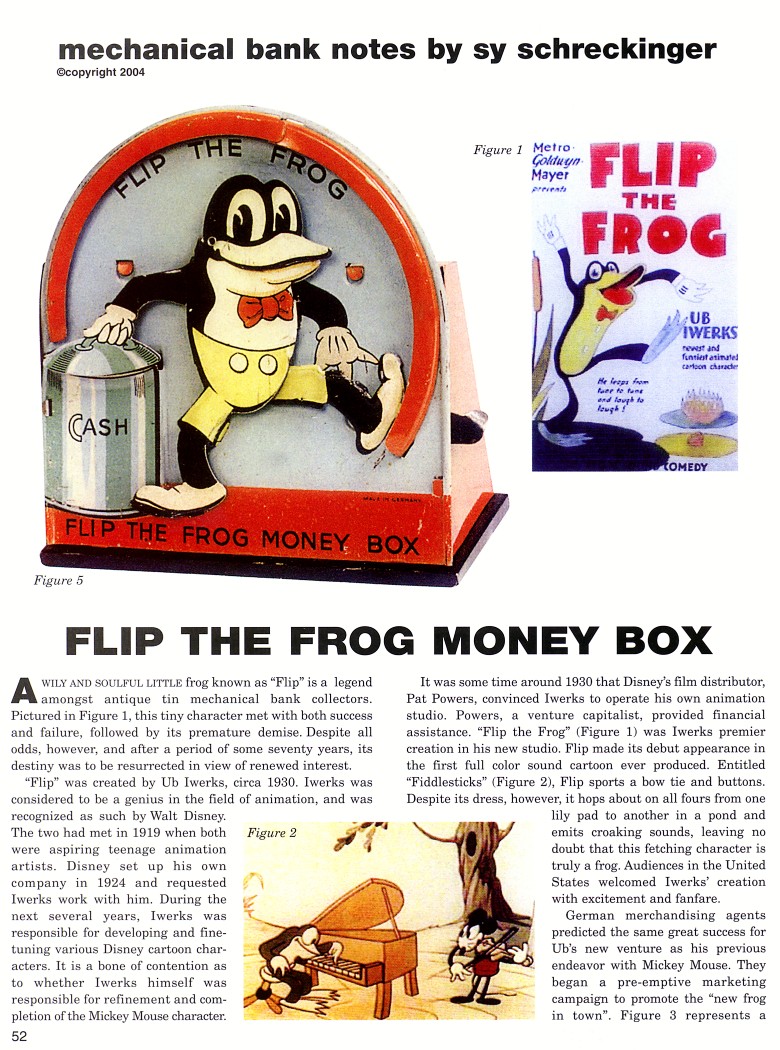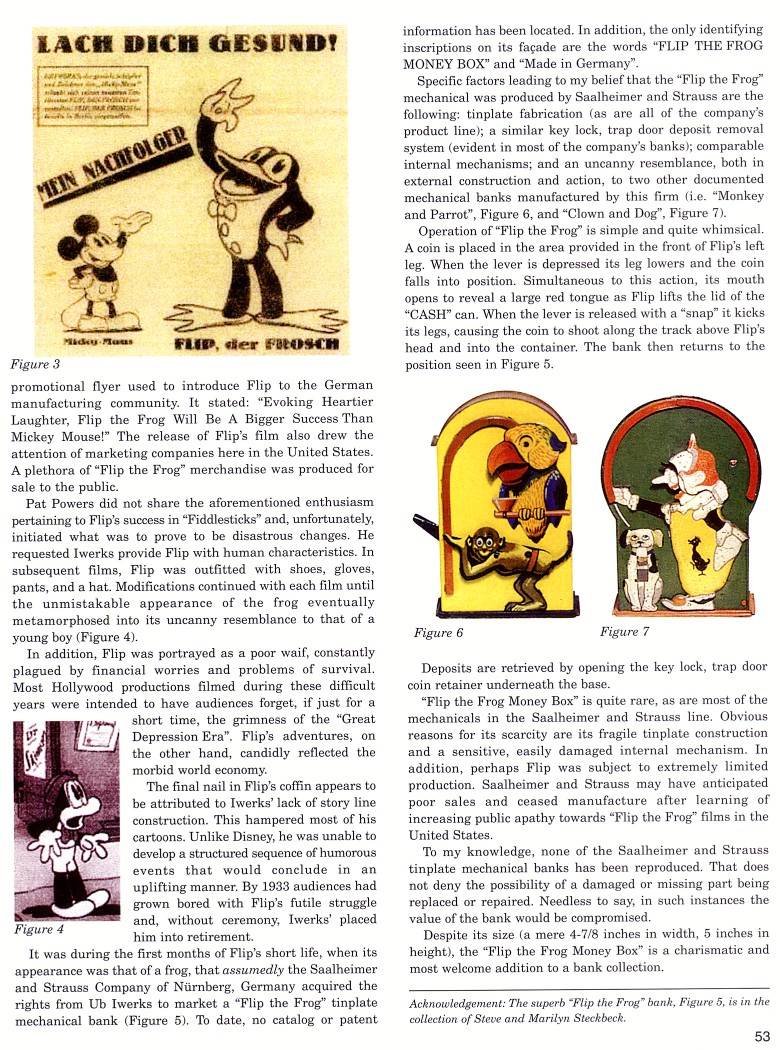|
Flip the Frog Money Box
by Sy Schreckinger – ANTIQUE TOY WORLD Magazine – October, 2004
A wily and soulful little frog known as "Flip"
is a legend amongst antique tin mechanical bank collectors. Pictured in
Figure 1, this tiny character met with both success and failure, followed
by its premature demise. Despite all odds, however, and after a period of
some seventy years, its destiny was to be resurrected in view of renewed
interest. "Flip" was created by Ub Iwerks, circa 1930. Iwerks was
considered to be a genius in the field of animation, and was recognized as
such by Walt Disney.
The two had met in 1919 when both were aspiring teenage
animation artists. Disney set up his own company in 1924 and requested
Iwerks work with him. During the next several years, Iwerks was
responsible for developing and fine-tuning various Disney cartoon
characters. It is a bone of contention as to whether Iwerks himself was
responsible for refinement and completion of the Mickey Mouse character.
It was some time around 1930 that Disney's film distributor, Pat
Powers, convinced Iwerks to operate his own animation studio. Powers, a
venture capitalist, provided financial assistance. "Flip the Frog" (Figure
1) was Iwerks premier creation in his new studio. Flip made its debut
appearance in the first full color sound cartoon ever produced. Entitled
"Fiddlesticks" (Figure 2), Flip sports a bow tie and buttons. Despite its
dress, however, it hops about on all fours from one lily pad to another in
a pond and emits croaking sounds, leaving no doubt that this fetching
character is truly a frog. Audiences in the United States welcomed Iwerks'
creation with excitement and fanfare.
German merchandising agents predicted the same great success for Ub's
new venture as his previous endeavor with Mickey Mouse. They began a
pre-emptive marketing campaign to promote the "new frog in town". Figure 3
represents a promotional flyer used to introduce Flip to the German
manufacturing community. It stated: "Evoking Heartier Laughter, Flip the
Frog Will Be A Bigger Success Than Mickey Mouse!" The release of Flip's
film also drew the attention of marketing companies here in the United
States. A plethora of "Flip the Frog" merchandise was produced for sale to
the public.
Pat Powers did not share the aforementioned enthusiasm pertaining to
Flip's success in "Fiddlesticks" and, unfortunately, initiated what was to
prove to be disastrous changes. He requested Iwerks provide Flip with
human characteristics. In subsequent films, Flip was outfitted with shoes,
gloves, pants, and a hat. Modifications continued with each film until the
unmistakable appearance of the frog eventually metamorphosed into its
uncanny resemblance to that of a young boy (Figure 4).
In addition, Flip was portrayed as a poor waif, constantly plagued by
financial worries and problems of survival. Most Hollywood productions
filmed during these difficult years were intended to have audiences
forget, if just for a short time, the grimness of the "Great Depression
Era". Flip's adventures, on the other hand, candidly reflected the morbid
world economy.
The final nail in Flip's coffin appears to be attributed to Iwerks'
lack of story line construction. This hampered most of his cartoons.
Unlike Disney, he was unable to develop a structured sequence of humorous
events that would conclude in an uplifting manner. By 1933 audiences had
grown bored with Flip's futile struggle and, without ceremony, Iwerks'
placed him into retirement.
It was during the first months of Flip's short life, when its
appearance was that of a frog, that assumedly the Saalheimer and Strauss
Company of Nurnberg, Germany acquired the rights from Ub Iwerks to market
a "Flip the Frog" tinplate mechanical bank (Figure 5). To date, no catalog
or patent information has been located. In addition, the only identifying
inscriptions on its facade are the words "FLIP THE FROG MONEY BOX" and
"Made in Germany".
Specific factors leading to my belief that the "Flip the Frog"
mechanical was produced by Saalheimer and Strauss are the following:
tinplate fabrication (as are all of the company's product line); a similar
key lock, trap door deposit removal system (evident in most of the
company's banks); comparable internal mechanisms; and an uncanny
resemblance, both in external construction and action, to two other
documented mechanical banks manufactured by this firm (i.e. "Monkey and
Parrot", Figure 6, and "Clown and Dog", Figure 7).
Operation of "Flip the Frog" is simple and quite whimsical. A coin is
placed in the area provided in the front of Flip's left leg. When the
lever is depressed its leg lowers and the coin falls into position.
Simultaneous to this action, its mouth opens to reveal a large red tongue
as Flip lifts the lid of the "CASH" can. When the lever is released with a
"snap" it kicks its legs, causing the coin to shoot along the track above
Flip's head and into the container. The bank then returns to the position
seen in Figure 5.
Deposits are retrieved by opening the key lock, trap door coin
retainer underneath the base.
"Flip the Frog Money Box" is quite rare, as are most of the
mechanicals in the Saalheimer and Strauss line. Obvious reasons for its
scarcity are its fragile tinplate construction and a sensitive, easily
damaged internal mechanism. In addition, perhaps Flip was subject to
extremely limited production. Saalheimer and Strauss may have anticipated
poor sales and ceased manufacture after learning of increasing public
apathy towards "Flip the Frog" films in the United States.
To my knowledge, none of the Saalheimer and Strauss tinplate
mechanical banks has been reproduced. That does not deny the possibility
of a damaged or missing part being replaced or repaired. Needless to say,
in such instances the value of the bank would be compromised.
Despite its size (a mere 4-7/8 inches in width, 5 inches in height),
the "Flip the Frog Money Box" is a charismatic and most welcome addition
to a bank collection.
Acknowledgement: The superb "Flip the Frog" bank, Figure 5, is in the
collection of Steve and Marilyn Steckbeck.
|


